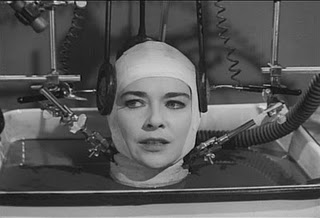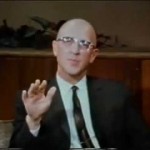One of last semester’s highlights was stumbling upon this gem of a lecture from the inimitable Carl Rogers. Rogers begins the 1974 talk by reflecting on the educational value of reviewing films of himself conducting person-centered counseling with clients. For my part, I was struggling mightily to find the value in reviewing videos of my own counseling sessions throughout the semester. In fact, I downright hated the process. Rather than obsess over everything I could have or should have done in a session already past, what I most wanted to do was observe a true master counselor at work. And so I watched as much of Carl Rogers as I could find online, and it helped to get me through. Enjoy!
The Embodiment of Freedom: An integral approach to optimal health and personal transformation (Part 5: The Technology of Alienation)
 [See parts 1, 2, 3, and 4 of the series]
[See parts 1, 2, 3, and 4 of the series]
It is important not to mistake the distinction between alienation and authenticity as a condemnation of the particular techniques that have supported the success and progress of a scientifically and technologically driven modern world. These techniques are, in-and-of-themselves, of neutral value. It’s the ways in which we integrate various techniques into our lives (the technology) that can either lead us either toward disconnection and diminished awareness or into levels of greater conscious connection and deeper self awareness, and these ways of responding to the challenges of life are shaped very early.
Beginning with the ways parents hold and touch their children, infants are learning how “to be” physically in the world. As they learn to mimic adults’ behavior, children are further educated on how to move and how not to move. Despite the potential for differences in this early upbringing, most young children are energetic, highly mobile, flexible, and authentically expressive beings. As children enter school, however, these tendencies are actively shaped like never before. As most of us have been schooled, children are typically made to sit in rigid desks for long periods of time. They must learn to ignore their natural inclinations as to how to move their bodies physically and express themselves verbally, expressing themselves only when some authority deems it acceptable and only in ways that are deemed acceptable. A child’s experience of fatigue, hunger, and excitement are brought into alignment with the pre-determined structure of the school day. Even during set periods for “free” expression, children are taught the “right way” to do everything, from throwing a ball to drawing a picture. Since kids’ developing sense of self-esteem is so wedded to the positive reinforcement they get for doing things “right,” expressing oneself in idiosyncratic ways is often met with discouragement from authority and ridicule from peers.
While peer groups exert relentless pressure to conform to the status quo, in the classroom bad grades are meted out to those who fail to do things “correctly,” and sometimes even physical punishment awaits those who allow their restlessness and bodily tensions to sneak out into their behavior. This training prepares children for life after school, where the organic rhythms of the body are regulated to fit the needs of the typical work situation. Food is eaten during a set lunch hour, one goes to the bathroom during scheduled breaks, and the range of overall body movement conforms to the prescribed limits of the given work setting. Johnson, in his book Body, summarizes this whole pattern of body-shaping as follows:
From infancy through old age we are taught to conform our bodies to external shapes. We learn to perform physical activities in specifically prescribed ways. We are rewarded for keeping quiet and controlling our bodily impulses. The implied meaning of these recurrent nonverbal messages is consistent with the explicit teachings: our bodies, with their feelings, impulses, and perceptions, are not to be trusted, and must be subjected to external controls to keep them from leading us astray. They must be trained to support the status quo.
The technology of alienation encourages individuals to exist in a state of continual repression, a dissociated state which truncates one’s depth of awareness as well as one’s range of responsiveness. This state of disembodiment manifests not only in a diminished and deadened sense of self, but also necessarily disembodies one’s relationships to others. Since we experience all situations in our lives with, through, and as bodily beings, to be dulled to our own bodily senses and feelings is to be dulled to the feelingful aspects of any relationship or situation we find ourselves in.
The dimension of consciousness that an alienated individual loses touch with is what humanistic psychologist Sidney Jourard called “somatic perception.” Jourard pointed out that people respond to all situations on a bodily-felt level, and that by perceiving subtle changes in the state of one’s bodily being, one can sense when a situation either enhances or diminishes the quality of one’s life. It’s on this embodied level that a little girl can tell which of the smiling adults in a room actually doesn’t like her; that we just “know” something is troubling a loved one, no matter how hard they try to hide it; that we simply get good or bad “vibes” about a particular situation. As a person loses the capacity to discern how situations affect him or her as an embodied being, it becomes all too easy to continue ways of living and relating that are not in one’s best interests. As Jourard put it:
When we repress the experience of our bodies, we not only reduce our experience of being alive, but, in order to protect ourselves from threatening pleasure and pain, we actually create circumstances by which we become stupid, that is, uninformed, in a peculiar, somatic way.
Thus, to the degree one lacks embodiment, one is ignorant of how to live situations in an authentic way.
As Johnson reminds us, authenticity is a word of Greek origin that originally meant “to do something oneself, to have a sense that one’s actions and feelings are one’s own.” When a person has a well-developed capacity for somatic perception, one is better suited to be one’s own authority on how to live in growth enhancing ways. This “sensual authority,” as Johnson calls it, comes directly from one’s sense of embodiment, and is precisely what is stripped away via the technology of alienation. When access to somatic perception is dulled, people progressively lose the necessary depth of awareness to possess a clear sense of how to be and what to do in life. As Johnson describes it:
The technology of alienation accustoms us to sense a void between ‘I’ and my flesh, and between ‘I’ and ‘you’. Because we are led to feel that we are not in immediate contact with the palpable world, we sense that we need experts who understand that world enough to tell us what to do.
Alienated from our embodied experience of self and world, we give doctors authority over our bodies, psychologists authority over our minds, outside mediators authority over our interpersonal disputes, governments authority over our environmental policies and actions, and religious leaders authority over our spirits. The shift from alienation to authenticity requires that individuals develop their impoverished self-sensing capacities and that they learn to check the dictates of outside authorities against this growing base of awareness.
Focusing
 The Buddhist magazine Tricyle recently posted an interesting article by David Rome called Focusing and Meditating, which explores the Focusing technique (developed by Eugene Gendlin in a psychotherapeutic context) and how it relates to the contemplative practice of Buddhist meditation. Rome describes Focusing as
The Buddhist magazine Tricyle recently posted an interesting article by David Rome called Focusing and Meditating, which explores the Focusing technique (developed by Eugene Gendlin in a psychotherapeutic context) and how it relates to the contemplative practice of Buddhist meditation. Rome describes Focusing as
bringing gentle, mindful awareness to a subtle level of bodily experiencing known as the “felt sense.” Felt senses, which lie somewhere between physical sensations and emotional feelings, represent a distinct kind of experience.
A long-time meditator, Rome describes how Focusing can be a complimentary contemplative practice. Whereas meditation cultivates an awareness and acceptance of experience “as it is” in any given moment, Focusing involves directly engaging specific issues and problems in life and discovering uniquely appropriate solutions. Although I myself have practiced both meditation and Focusing, I haven’t thought much about how the two methods relate to one another, and I found Rome’s perspective on this to be fascinating. For those interested in more about Focusing, below are some notes of my own:
Eugene Gendlin developed the Focusing technique at the University of Chicago, where he and his colleagues conducted research in which they found that the single most important factor in psychotherapy affecting positive outcome was the client’s ability to contact and work with his or her bodily-felt sense. It was not enough, argued Gendlin, to have a rational understanding of one’s psychological issues. Many clients with exquisite theoretical and conceptual psychological understandings often continue to remain stuck in the same stultifying patterns. According to this line of research, the key to healing lies in developing one’s awareness of the bodily-felt dimensions of experience.
Gendlin was a colleague of Carl Rogers, one of the founders of Humanistic Psychology. Rogers had long suggested that an attentiveness toward bodily-felt dimensions of experiencing was a key element of successful psychotherapy. What Gendlin did was develop this suggestion into a concrete methodology that has since been successfully taught to many people, both in and outside of a therapy setting. Gendlin’s perspective is founded on the notion that, in all situations and at any given time, there is an ongoing psychophysiological flow of experiencing that can be attended to in such a way as to concretely transform the way we live a particular situation. Not simply sensations of the “body”, this felt-sense is holistic, in that it implicitly contains one’s sense of the “whole thing” of a particular situation, including what one has learned conceptually. As Gendlin puts it (in his book Focusing):
The felt-sense is in the body, yet it has meanings. It has all the meanings one is already living with because one lives in situations with one’s body. A felt-sense is body and mind before they are split apart.
In other words, the felt-sense is of the integrated bodymind. It is experienced as both sensual and meaningful. To get a flavor of the felt-sense, let’s look at the familiar “tip of the tongue” experience. You know the name of that movie starring your favorite actor, but you just can’t access that knowledge at the moment. There’s absolutely no doubt that the knowledge is within you somewhere — it’s right on the tip of your tongue. Although you can’t name the movie, you can sense what the name is in an unclear way. This hazy place that feels meaningful yet not fully known is a felt-sense. It is sensed in the body as a vital, sensual flow of experiencing that contains meanings in an implicit way. When the implicit meaning is revealed, there is an unmistakable shift in the way we relate to the given concern, a shift that is experienced as a feeling or inner bodily movement that releases the sought after knowledge. This can also be described as an “a-ha” experience.
This felt-shift or sense of a-ha is also an experience on the level of the integrated bodymind — not just a sensation in our “bodies” nor merely an idea or concept popping up in our “minds”. Other familiar examples of the shifting felt-sense include having someone else successfully complete a sentence for us while we struggle to find the right word, and the “I know I forgot something but I just can’t figure out what it is” scenario. In each of these situations, meaningful knowledge is arrived at only when there is the right “fit” between a particular concept and one’s bodily-felt experience of the situation. If you are experiencing the felt-sense that you forgot to bring something (which turns out to be your camera) to the airport, then only a conceptual scheme having to do with your camera comes with the release of the felt-shift. Even if, while rifling through your memory, you realize that you also forgot your tooth-brush, you can “just tell” that your sense of concern had to do with something else, since the tooth-brush revelation brought no shift in the felt-sense. These familiar examples of the felt-sense are illustrative, in a very basic way, of the level of inquiry that characterizes Gendlin’s technique of experiential Focusing.
Focusing can be looked at as a process of being with one’s felt experience as it unfolds in relation to an issue, problem, or a situation. Most situations, of course, are not nearly as clear-cut as the above, everyday scenarios. When something is on the tip of our tongues, we already know a lot about the particular type of knowledge we’re looking for — perhaps a movie title or someone’s name. When the concern, issue, or situation is more complex, the associated felt-sense is experienced as much more unclear, fuzzy, and unrecognizable. However, while the felt-sense is always initially experienced as unclear and unknown, it is also always distinct, in that it feels ripe with potential meanings in relation to a particular situation or concern. I can choose to focus on any aspect of my experiencing — my mother, my job, this blog post, my physical health — that is potentially meaningful for me, and each associated felt-sense will feel uniquely unclear initially.
In the context of personal transformation, where one’s intent is to change the way one lives in relation to some aspect of experience, the first step of the focusing process is to bring attention to the bodily-felt experience of a particular concern, identifying the felt-sense as the somewhat hazy, hard to discern global sense that surrounds it. As one stays focused on this unclear sense, one can become more and more clear about what it is they’re feeling, allowing various shades of meaning to emerge by the skillful use of open ended questions. (David Rome summarizes some specific steps to Focusing HERE.)
In Focusing, intellectual analysis of feelings and immediate mental answers to questions are identified and gently turned away in favor of responses which are experienced as emerging from the felt-sense itself. For instance, I can ask myself “is there anything keeping me from being happy and full of life right now?”, and then immediately try to mentally answer the question with things that I rationally already identify as problem areas of my life. I might say to myself, “I hate my boss, I’m not getting enough sex, and I’m fighting a cold”. This question-answer session, however, is not Focusing. This manner of questioning is, in a way, rhetorical — the response consisting of things I already know. Nothing new is discovered, there is no felt-shift to indicate a movement or change on the level of bodymind. In Focusing, one asks a question of themselves and then attends to the unclear yet distinct bodily-felt sense that feels meaningful in relation to that question. One asks and then waits for a response to bubble up from the felt-sense, focusing on it until some aspect of it becomes clear. To my question as to what might be blocking full-living, images having to do with my mother might unexpectedly come up. As I say the words “it may have something to do with Mom”, a unmistakable shift in the felt sense — the sense of a-ha — would indicate that I might benefit from focusing further on whatever issues might be related to my mother. Further open-ended questions, such as “What is it about my Mom that feels unresolved?”, or “Exactly what am I am feeling, right now, in relation to Mom?”, might allow the feeling of stuckness or blockedness to loosen its grip on me and rest at a place of greater resolution.
The bodily felt shift in response to an open ended question is the concrete experience of bodymind connection that is the hallmark of experientially-oriented approaches to psychotherapy. Thoughts and concepts are continually checked against the felt sense in the process of Focusing, giving the focuser access to a wider store of wisdom than the thinking mind alone.
Erich Fromm interviewed by Mike Wallace, 1958
The Society for Humanistic Psychology blog posted the following video of Erich Fromm being interviewed by Mike Wallace in 1958. [A complete transcript of the interview can be accessed via the Harry Ransom Center (University of Texas at Austin) website.] A couple of things stuck me as I watched this fascinating exchange. First, Fromm’s essential critique of modern society is as relevant today as it was fifty years ago. Second, I find it difficult to imagine any news program today featuring this kind of in-depth, philosophical discussion. We’ll see weeks of non-stop news coverage on say, the death of Michael Jackson, but when it comes to exchanging thoughtful perspectives on our most pressing societal problems, we’re offered little more than partisan sound-bites and propaganda disguised as journalism.
The program below is introduced as a “Special series discussing the problems of survival and freedom in America”. Mike Wallace begins by saying that his aim in talking with Fromm is to “try to measure the impact of our free society on us as individuals. Whether we’re as happy as we like to think we are, or as free to think and to feel.” Imagine Bill O’Reilly or Brian Williams or Katie Couric devoting an entire program to such questions! These kinds of questions are incredibly important, yet conspicuously absent from public discourse. In terms of Integral Health, it is simply impossible to understand individual health and happiness without understanding the way our individual lives are shaped by societal forces.
During the discussion, Fromm talks about the “marketing orientation” of the American citizenry of the 1950s: “Our main way of relating ourselves to others is like things relate themselves to things on the market. We want to exchange our own personality – or as one says sometimes, our ‘personality package’ – for something.” Fromm (I’m paraphrasing here) goes on to describe modern social relationships as shallow, with real intimacy being hidden by a superficial friendliness. He suggests that the average American is only genuinely concerned with private affairs, never losing sleep about the pressing societal problems which threaten our very existence. He says the average person prefers to leave such things to specialists in the government, talking about problems shown on the news with friends and coworkers, but with no more sense of urgency than one would talk about a car that needs repair. Fromm asserts that, despite our apparent preoccupation with it, true love remains a relatively rare phenomenon. He laments that it is all too common that the most important things we talk about on Sundays are the very things that we pay relatively little attention to in our everyday lives. Again, he’s talking about life in the 1950s, but it’s easy to be struck with how little things have changed, at least in many respects. Like when he says: “I think our danger is that we talk one thing, and we feel and act another thing. I mean, we talk about equality, about happiness, about freedom – and about the spiritual values of religion, and about God – and in our daily life, we act on principles which are different, and partly contradictory.”
Speaking of the “religious renaissance” he was seeing back then, Fromm describes it as “the greatest danger that true religious experience has ever been confronted with.” He goes on to say that man today, being concerned with production and consumption as ends in themselves, has very little energy and time to devote himself to the true religious experience, which Fromm defines (in response to Wallace) as “the capacity to feel deep love and oneness with others and nature.” Wallace also asks Fromm to define “happiness” and “democracy”. Regarding happiness, Fromm offers: “People today seem to define happiness as the experience of unlimited consumption. Happiness should be something which results from the creative, genuine, intense relatedness – awareness, responsiveness, to everything in life – to man, to nature.” Regarding democracy he says: “Democracy once meant an organizational society and a state, in which the individual citizen is – feels – responsible, and acts responsibly, and participates in decision-making. I think what democracy means today, in reality, is to a large extent, manipulated consent – not forced consent, manipulated consent -and manipulated more and more with the help of Madison Avenue.” Fromm adds, “We have a mass man, a mass bureaucracy, a manipulation of everyone to act smoothly but with an illusion that he follows his own decisions and opinions.”
Fromm gives Wallace–and the people watching this ABC News Special–a lot to chew on. Again, I think many of Fromm’s concerns and observations are just as relevant today as they were fifty years ago. Without further ado:


